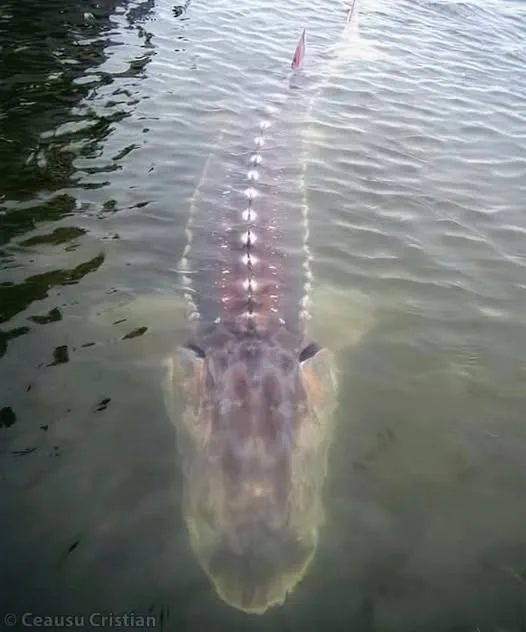Imagine gazing into the seemingly placid waters of a river, only to be met by the awe-inspiring sight of a creature that seems to defy time itself. That’s precisely the experience recently reported in the Kennebec River, Maine, where a massive, 4-meter (13-foot) sturgeon was spotted, a powerful reminder that our waters are still home to true living giants.

The image provided beautifully captures this sense of scale and ancient majesty. From an overhead perspective, we see the broad, almost prehistoric head of a sturgeon just beneath the water’s surface, its long, muscular body extending into the depths. The distinctive rows of bony plates, or scutes, along its back are clearly visible, giving it that iconic “armored” appearance that harkens back to a time when dinosaurs roamed the Earth. The water, clear enough to reveal its impressive form, ripples gently around it, highlighting the grace with which such a colossal creature moves through its aquatic realm.
Sturgeons are, quite literally, living fossils. Their lineage stretches back over 200 million years, making them far older than the dinosaurs. They’ve witnessed continents shift, ice ages come and go, and countless species rise and fall. Their survival across such immense geological timescales is a testament to their incredible adaptability and resilience.
These ancient fish are easily recognizable by their elongated bodies, a flattened snout, and the aforementioned rows of bony plates instead of scales. They are bottom-feeders, using sensitive barbels near their mouths to detect prey like crustaceans, worms, and small fish in the murky riverbeds and ocean floors.
While the 13-foot sturgeon in the Kennebec River is undoubtedly a magnificent specimen, it still pales in comparison to the largest sturgeons ever recorded. The undisputed heavyweight champion belongs to the Beluga sturgeon, a species found primarily in the Caspian and Black Seas. In 1827, a Beluga sturgeon caught in the Volga estuary measured a staggering 7.2 meters (24 feet) – roughly the length of a small bus – and weighed more than 1.5 tons (3,463 lbs)! Imagine reeling in a fish the size of a rhinoceros!
The presence of such large sturgeons in rivers like the Kennebec is a positive indicator of improving environmental health. These fish are highly sensitive to pollution and habitat degradation, and their recovery in various waterways is often a sign of successful conservation efforts. However, many sturgeon species worldwide still face significant threats from overfishing (especially for their valuable roe, or caviar), habitat loss, and dams that block their migration routes.
The sturgeon, with its armored body, ancient lineage, and impressive size, truly stands as a powerful symbol of nature’s enduring strength and resilience. Spotting one is more than just seeing a big fish; it’s encountering a living piece of Earth’s deep history, a creature that has navigated the currents of time for eons. It serves as a compelling reminder of the incredible biodiversity that still exists in our waters and the vital importance of protecting these magnificent giants for future generations. Let the sight of this Kennebec River leviathan inspire us to cherish and conserve these awe-inspiring living fossils.





